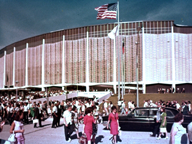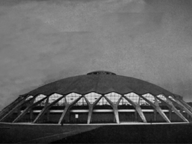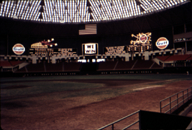

Architects: Wilson, Morris, Crain & Anderson; Lloyd, Morgan
& Jones
Roof Structural Engineers: Walter P. Moore & Associates;
Roof Structures, Inc.
The first American covered superstadium opened in April 1965; later that year the Reverend Billy Graham held an evangelical meeting under its steel, lamella-truss roof and called the Astrodome "the eighth wonder of the world," an epithet Houstonians continue to embrace with pride even if many subsequent stadiums have surpassed theirs in size and efficiency. Estimates of its final cost range from $45.35 to $48.9 million in 1965 dollars. The Astrodome covers a 150,000 square-foot playing field with a domed roof 642 feet in diameter. Setting a precedent that continues to this day, most of the funds for its construction were public, in this case local bond issues, while a private individual profited most from its successful completion.
 The Astrodome was masterminded by a colorful Houstonian named
Judge Roy Hofheinz (d. 1982), who in the early 1960s paid $5 million
for 495 acres of swampland 6 miles south of downtown Houston,
spent $1.2 million to drain it, and then sold 180 acres to Harris
County for $5 million, retaining the remaining 315 acres to develop
into the privately-owned complex that today contains a hotel,
a convention hall complex, and the Astroworld Amusement park.
Using his political influence (he had been a county judge, mayor
of Houston, state legislator, and Lyndon B. Johnson's campaign
manager), Hofheinz induced the Texas highway department to accelerate
plans to build Loop 610, which today borders the site. Meanwhile,
he bought a controlling portion of shares in the Houston Colt
.45s, an undistinguished baseball team which had been franchised
in 1962. He changed the team's name to the Houston Astros to honor
the recent arrival of NASA's huge manned spacecraft center, which
would put a man on the moon in 1969. Hofheinz claims to have been
inspired by the velarium unfurled by Roman slaves in inclement
weather to shield wealthy visitors to the Colosseum, claiming
"if those Romans can put a lid on their stadium, so can we."
A more proximate source of inspiration was Pier Luigi Nervi's
concrete lamella-trussed, multipurpose Palazzeto dello Sporto
in Rome (1957, figure 1), which Hofheinz had seen in a recent
issue of Sporting News. A covered stadium, he claimed, would put
Houston on the map: "nobody can see [the Astrodome, then
under construction] and go back to Kalamazoo, Chicago, New York,
you name it and still think this town is bush league, that this
town is Indian territory."
The Astrodome was masterminded by a colorful Houstonian named
Judge Roy Hofheinz (d. 1982), who in the early 1960s paid $5 million
for 495 acres of swampland 6 miles south of downtown Houston,
spent $1.2 million to drain it, and then sold 180 acres to Harris
County for $5 million, retaining the remaining 315 acres to develop
into the privately-owned complex that today contains a hotel,
a convention hall complex, and the Astroworld Amusement park.
Using his political influence (he had been a county judge, mayor
of Houston, state legislator, and Lyndon B. Johnson's campaign
manager), Hofheinz induced the Texas highway department to accelerate
plans to build Loop 610, which today borders the site. Meanwhile,
he bought a controlling portion of shares in the Houston Colt
.45s, an undistinguished baseball team which had been franchised
in 1962. He changed the team's name to the Houston Astros to honor
the recent arrival of NASA's huge manned spacecraft center, which
would put a man on the moon in 1969. Hofheinz claims to have been
inspired by the velarium unfurled by Roman slaves in inclement
weather to shield wealthy visitors to the Colosseum, claiming
"if those Romans can put a lid on their stadium, so can we."
A more proximate source of inspiration was Pier Luigi Nervi's
concrete lamella-trussed, multipurpose Palazzeto dello Sporto
in Rome (1957, figure 1), which Hofheinz had seen in a recent
issue of Sporting News. A covered stadium, he claimed, would put
Houston on the map: "nobody can see [the Astrodome, then
under construction] and go back to Kalamazoo, Chicago, New York,
you name it and still think this town is bush league, that this
town is Indian territory."
Cultural Impact
 Many
of the changes in American sports that became more visible with
the construction of subsequent domed stadiums were intimated in
the configuration of the Houston Astrodome. A round, multi-use
structure that departed from the diamond shape traditional to
older baseball stadiums, the Astrodome lacked the idiosyncratic
architectural features and connections to surrounding topography
that made each older stadium a distinct place with its own character.
The resulting sense of placelessness was exacerbated by the designer's
embrace of the latest developments in electronic media. The Astrodome
was the first major-league stadium equipped with adequate lighting
for color television, and its 60-by-300 foot-long electronic scoreboard
(figure 2) provoked critics to complain that American sports fans
were being transformed unawares from active psychological participants
in a local game to passive recipients of a big-business entertainment
spectacle--Roger Angell, the sports writer for the New Yorker,
noted early on that viewers in Houston watched the screen more
often than they did the game. Finally, the Astrodome, like all
subsequent stadiums, included "luxury boxes" that sequestered
the rich in carpeted rooms behind plate glass, duplicating the
class stratification of American society that had been levelled
in older stadiums as rich and poor alike sat in uncomfortable
bleachers in the rain, shouting for the home team.
Many
of the changes in American sports that became more visible with
the construction of subsequent domed stadiums were intimated in
the configuration of the Houston Astrodome. A round, multi-use
structure that departed from the diamond shape traditional to
older baseball stadiums, the Astrodome lacked the idiosyncratic
architectural features and connections to surrounding topography
that made each older stadium a distinct place with its own character.
The resulting sense of placelessness was exacerbated by the designer's
embrace of the latest developments in electronic media. The Astrodome
was the first major-league stadium equipped with adequate lighting
for color television, and its 60-by-300 foot-long electronic scoreboard
(figure 2) provoked critics to complain that American sports fans
were being transformed unawares from active psychological participants
in a local game to passive recipients of a big-business entertainment
spectacle--Roger Angell, the sports writer for the New Yorker,
noted early on that viewers in Houston watched the screen more
often than they did the game. Finally, the Astrodome, like all
subsequent stadiums, included "luxury boxes" that sequestered
the rich in carpeted rooms behind plate glass, duplicating the
class stratification of American society that had been levelled
in older stadiums as rich and poor alike sat in uncomfortable
bleachers in the rain, shouting for the home team.
As for the Astrodome's effect on Houston, the stadium has lost money virtually every year since it opened but nonetheless was always considered a success. A year after opening it became America's third-most-visited man-made tourist attraction, behind only Mount Rushmore and the Golden Gate Bridge. It did become the anchor for the subsequent development of south Houston, and some economists estimate that, when the "rollover effect" (dollars brought into an area by economic investment, then respent locally) is taken into account, the Astrodome brought profits to the city in excess of $4 billion.
Sources:
Angell, Roger. "The Cool Bubble." In The Summer Game. New York, Viking, 1972.
Kammer, David John. "Take Me Out to the Ballgame: American Cultural Values as Reflected in the Architectural Evolution and Criticism of the Modern Baseball Stadium." PhD. Dissertation, University of New Mexico, 1982.
Karp, David A. and William C. Yoels. "Sport and Urban Life." Journal of Sport and Social Issues. (*): 77-102.
Leerhsen, Charles. "Happy Birthday, Old Dome." Newsweek (15 April 1985): 11.
Lipsitz, George. "Sports Stadia and Urban Development: A Tale of Three Cities." Journal of Sport and Social Issues 8, no. 2 (19**): 1-18.
Ray, Edgar W. The Grand Huckster [biography of Hofheinz]. Memphis: Memphis State University Press, 1980.
Webb, Bruce C. "Diamond in the Round: The Astrodome Turns 25." Cite: The Architecture and Design Review of Houston 24 (Spring 1990): 7-10.
Various newspaper articles in The Houston Chronicle and The Houston
Post.